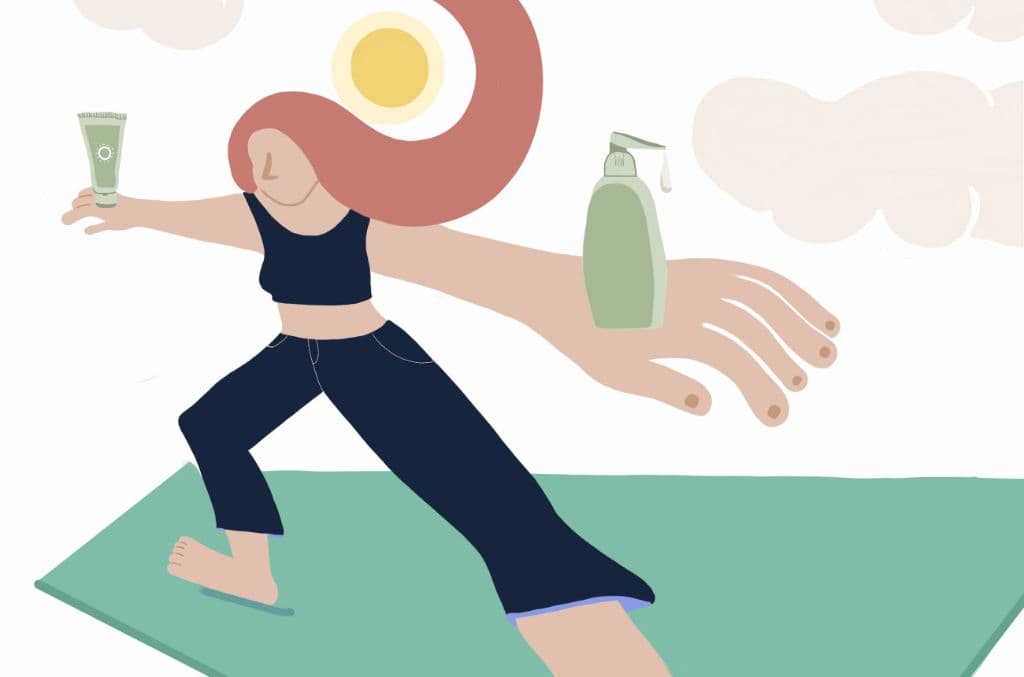Most of us have finally started working on a regular fitness routine at home thanks to the lockdown. The endorphin surge from that HIIT workout or yoga is the only thing keeping us sane at this point! While some people had their regular gym-wear and equipment in place, many of us had to scramble for appropriate clothing and yoga mats to get comfortable with the change of pace. The Indian summer hasn’t made things easier either, and the muggy monsoon poses another challenge when nothing seems to dry and microbes abound (yippee). This changing weather alongside your new-found exercise regimen is sure to have effects on your skin, so here’s a routine to follow as you work on your fitness goals, either at home or outdoors!
Before exercising-
Sun protection- This is the most important factor when you step outdoors, from sunrise to sunset. Why do you need it? The immediate effect of UV light is sun-tan or sun-burn, depending on your skin type. A delayed and cumulative effect is premature skin ageing, leading to early wrinkling and age-related spots called lentigines. Skin cancer, though not as common in Indians as it is in Caucasians, can occur with prolonged sun exposure over time.
A simple rule to follow- Apply sunscreen on the face and exposed parts of the body 20 minutes before stepping outside. Re-apply it after 2-3 hours if you are staying outdoors the whole day, as its effect wears off over time. Try to avoid exercising outdoors between 9am and 3pm, as the UV light is strongest at this time, irrespective of cloud coverage.
How to choose- There are over a hundred sunscreens to choose from. A broad-spectrum sunscreen (covers UVA and UVB) with SPF of at least 30 is required for protection. For the face, you can invest in a sunscreen that suits your skin: an oily skin type would prefer a gel-based or matte-finish sunscreen, while dry skin type would prefer a cream-based sunscreen. Tinted sunscreens are available too, which blend in well, like foundation. For the body, sunscreen lotions spread easily.
For children and expectant mothers, ‘mineral’ or ‘physical’ sunscreens with ‘zinc and titanium oxides’ are safe to use. Water-resistant sunscreens are best for swimming activities. These should be applied on the back of the neck, back and top of your feet as well if they are exposed. A lip-balm with SPF is also helpful.
In addition to this, a cap covering the face, and sunglasses will really be helpful. Clothes also offer sun-protection- dark or bright colors, closely-woven material like nylon and long sleeves offer the best protection. Look for UPF (UV protection factor) clothing for activities like hiking. Don’t forget that your hair gets bleached by UV radiation, so cover it up or tie up and protect it in a cap if you can.
Apparel- I choose shorts or trackpants over polyester tights, and a loose-fitting cotton or moisture-wicking ‘climacool’ or ‘climalite’ t-shirt. Inner wear must be cotton- it minimizes the chances of developing fungal rashes (commonly known as ringworm, but is not a worm), back and buttock acne. Even chafing and blackening of the thighs is avoided when you wear loose, soft clothing which minimises friction against the skin.
Your yoga mat will tend to accumulate microbes with the sweat from your workout. The chances of contracting bacterial infections like ‘staph’ and fungus are high when a mat is shared, so please wipe it down with a spray of water and few drops of dishwashing liquid and dry the mat after every use, and if possible, avoid sharing it.
Foot care- Sneakers with a comfortable fit are essential to prevent shoe-bites and injury to the toenails. Air dry the shoes after every workout. Keep the toenails short. Avoid barefoot exercise as this can lead to the development of corns due to the uneven pressure on the soles of your feet, bacteria enter through microscopic cuts, and viral warts occur from walking barefoot These are painful and healing takes time, which can disrupt your exercise routine..
Socks must be worn as it prevents foot blisters from developing. Wash them after every use as you can get fungal infections on the foot (athletes foot) and the nails too. Excessive sweating on the soles tends to increase the chance of athlete’s foot. If talcum powder doesn’t keep your feet dry enough, consult a dermatologist for options to control sweating- specific lotions containing aluminium salts, and sometimes oral medication can help.
After exercising
A clean thin towel should be kept handy to dab off excess sweat. A soft towel will prevent you from developing frictional acne. Make sure you dry the towel, or use a fresh towel for every workout.
Bathing immediately after a workout prevents infections from developing in the body folds. Change into fresh, dry clothes if you cannot bathe immediately as sweaty skin tends to attract fungal infections.
A cold or lukewarm bath is actually much better than a hot bath. It reduces redness and sensitivity of the skin by constricting the cutaneous blood vessels, does not strip the skin of all its natural oils, and gives the hair a shine by closing the hair cuticles. It’s especially great for people with naturally dry skin and eczema. Soaking in a bathtub or sitting in the sauna are practices that won’t do your skin any favors, but instead can dry the skin and increase chances of superficial bacterial infections (cooking in all that steam!)
Soap- you do not have to use an antibacterial soap, any regular soap bar or shower gel is perfectly fine. Avoid soap on the face, and instead use a face wash that suits your skin type. Never share your soap, towel, razor or comb.
Moisturizing is essential in maintaining your skin barrier, more so when you exercise. Immediately after a bath, use a moisturizing lotion for the body and face. Avoid using oil on the back asit can lead to acne and folliculitis (bacterial infection of the hair root). Moisturize your soles as well.
Stretch marks tend to develop if you workout intensively to gain muscle. Instead, try to gain muscle gradually, and moisturise the stretch marks to minimize them. There aren’t any specific effective treatments for them, unfortunately.
An interesting point to note if you are losing weight rapidly with intensive exercise is that loss of volume from the face occurs too, which tends to make the face look prematurely aged. So you may want to avoid drastic and rapid weight loss. A gradual approach is better.
Some personal favourite product recommendations for India :
- Sunscreen for face: Faceguard sunscreen SPF 30
- Sunscreen for body: Rivela sunscreen lotion SPF 50
- Mineral sunscreen: Neutrogena SheerZinc Drytouch sunscreen SPF 50
- Waterproof sunscreen: Banana Boat sunscreen lotion SPF 30
- Tinted sunscreen: Rivela Tint SPF 50
- Antibiotic cream for cuts, boils: Fucidin cream
- Soap for oily skin with body odor: Soapex soap
- Moisturizer: Cetaphil moisturizing lotion, Vaseline body lotion
- UPF clothing: Decathlon
If you have body acne, pus boils, itchy rashes in the folds, hands and feet, nail discoloration, or cracked feet, you should consult a dermatologist. There are simple treatments for all these, but you need a professional to attend to them.
You may have 99 problems but exercise hygiene ain’t one of them!
Disclaimer : This information is provided for educational purposes and should not be construed as medical advice. Please consult with your healthcare practitioners before undertaking any changes in your diet or adding supplements.
ProactiveForHer is a digital clinic for women, offering accessible, personalized, and confidential health-care solutions. We offer products and services for out-patient health concerns of Indian women, across their lifetime - from puberty to pregnancy to menopause. To know more on the sexual and reproductive health of women, visit https://www.proactiveforher.com/

